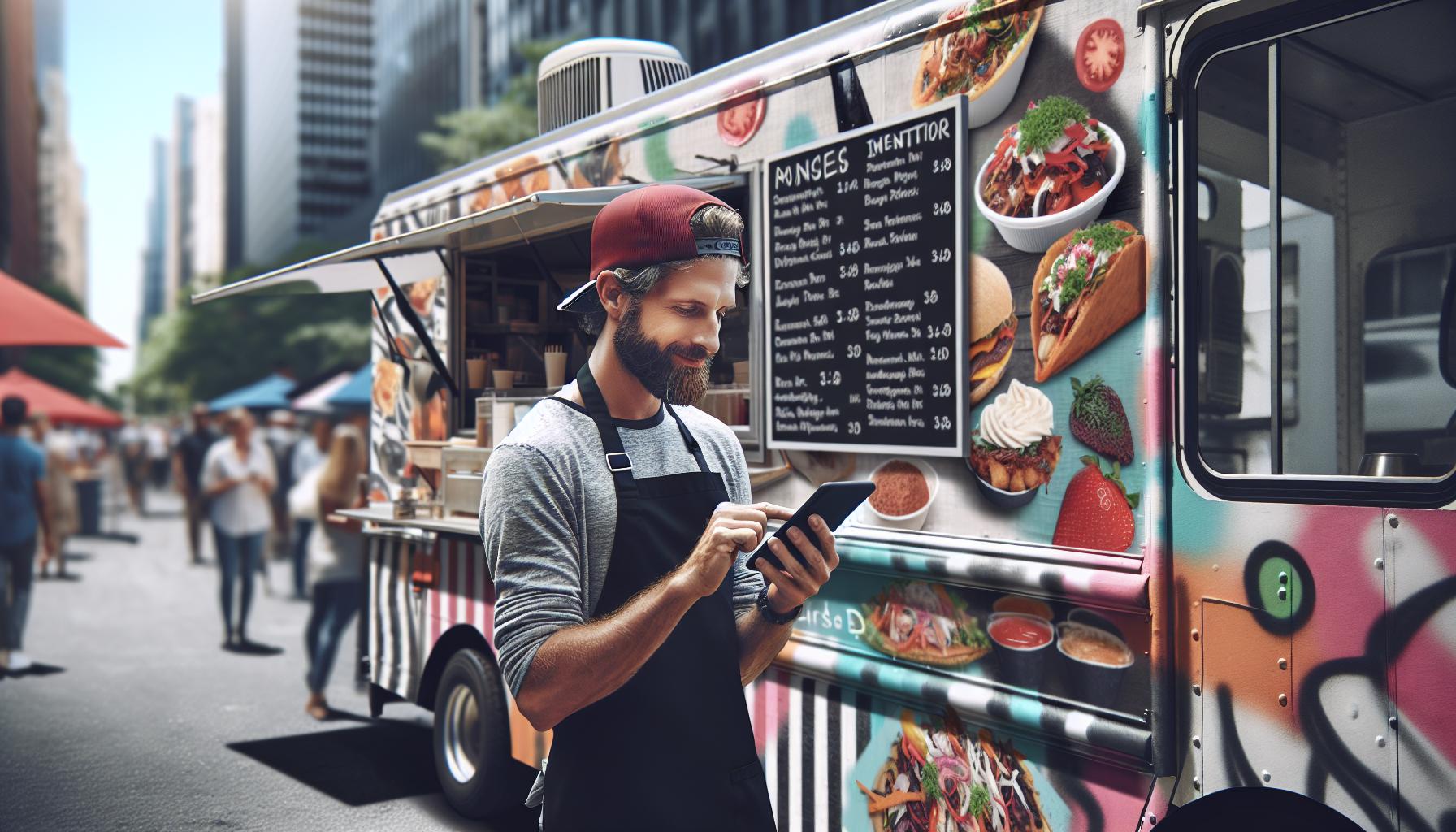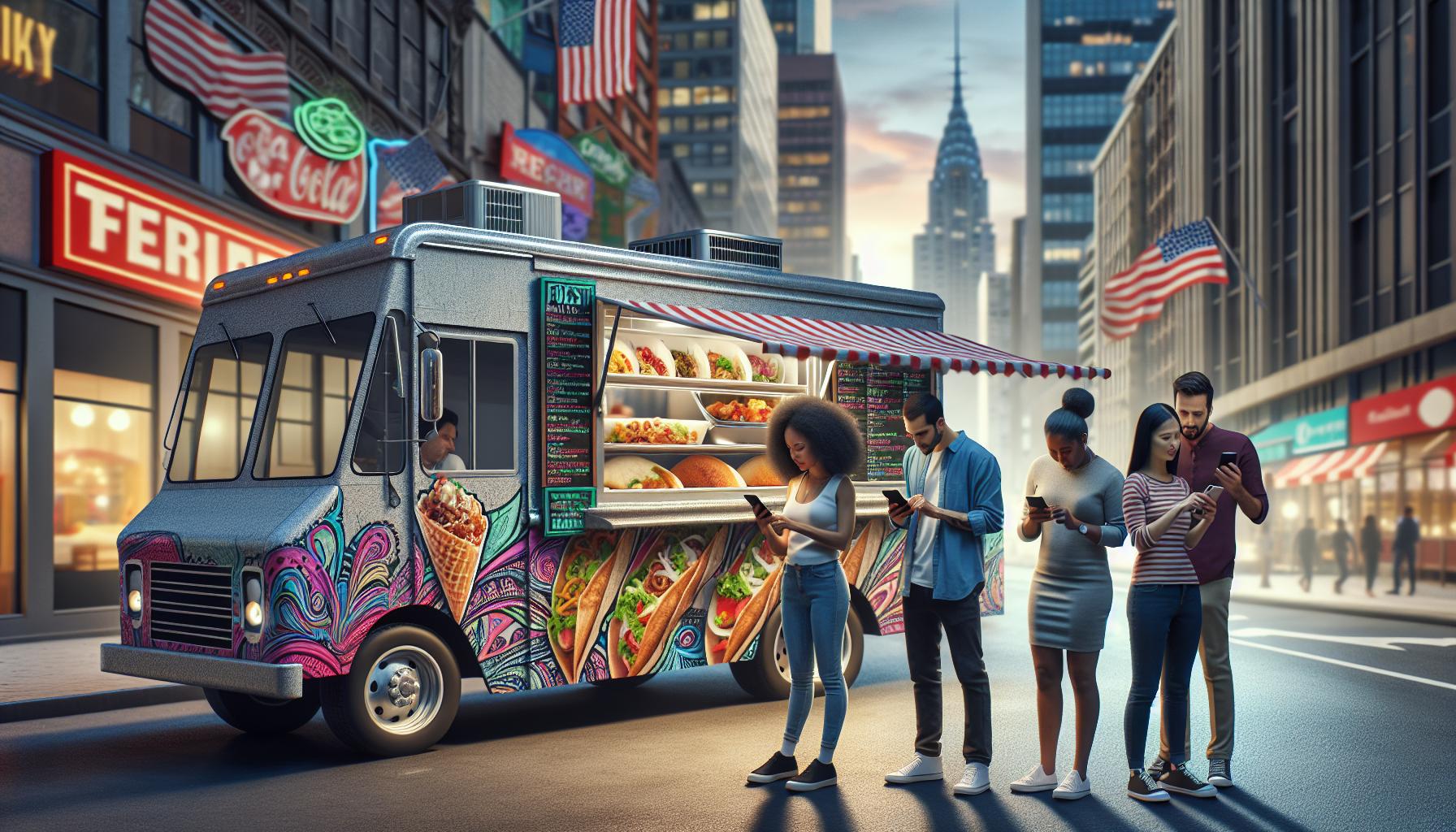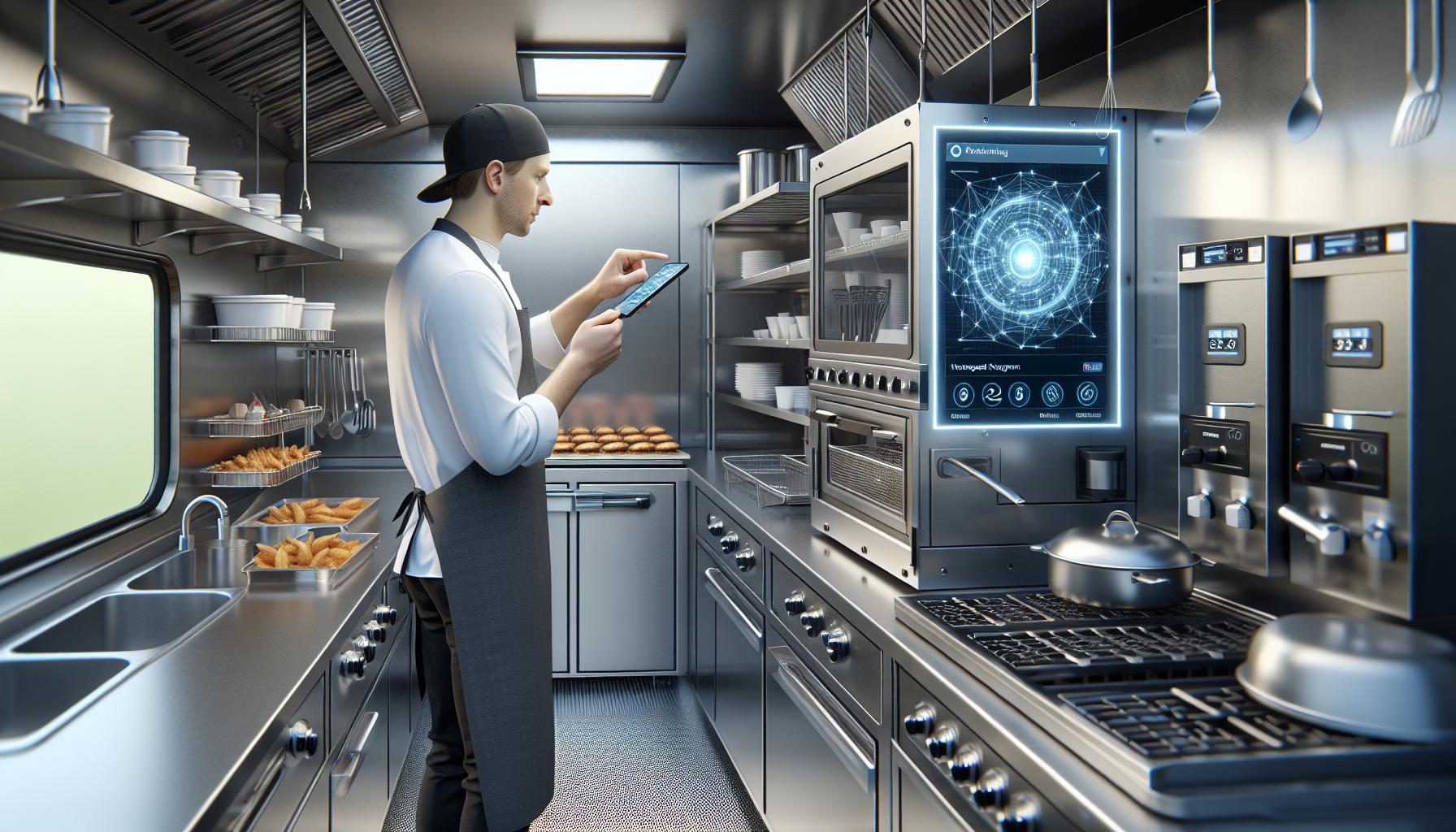Food trucks have evolved far beyond the basic hot dog stands of yesteryear. What Technological Trends Affect The Industry of Food Trucks- Today’s mobile eateries are embracing cutting-edge technology that’s transforming how they serve, connect and thrive in the competitive food service landscape. From cloud-based POS systems to AI-powered inventory management, these rolling restaurants are becoming smarter by the day.
The intersection of food and technology has created exciting opportunities for food truck operators to streamline their operations and enhance customer experiences. With consumers increasingly demanding convenience and digital accessibility, food truck owners who adapt to these technological trends aren’t just surviving – they’re revolutionizing the industry. Modern food trucks now leverage everything from mobile apps to social media analytics to stay ahead of the curve and keep their wheels turning profitably.
What Technological Trends Affect The Industry of Food Trucks
Mobile payment technology transforms food truck operations through streamlined transactions and enhanced customer convenience. Digital payment solutions reduce cash handling complexities while increasing transaction speeds and security.
Contactless Payment Systems
Food trucks equipped with NFC-enabled terminals process payments through tap-to-pay cards and smart devices. These systems eliminate physical contact during transactions, maintaining hygiene standards in food service environments. Modern contactless terminals integrate with existing POS systems to track sales data, manage inventory and generate detailed financial reports. The average transaction time decreases from 12 seconds for cash payments to 3 seconds for contactless payments, enabling food trucks to serve more customers during peak hours. Enhanced security features like tokenization and encryption protect customer payment data while reducing fraud risks.
Digital Wallets Integration
Food truck operators connect multiple digital payment platforms including Apple Pay, Google Pay and Samsung Pay through unified payment terminals. Integration with popular digital wallets expands customer payment options while simplifying the checkout process. Digital wallet transactions provide instant payment confirmation and automated receipts directly to customers’ mobile devices. Modern POS systems support QR code payments from regional digital wallet providers such as Venmo and PayPal, increasing accessibility for diverse customer segments. Transaction data from digital wallets integrates with analytics tools to generate insights about customer behavior patterns and purchasing preferences.
Cloud-Based Point of Sale Systems

Cloud-based POS systems transform food truck operations through centralized management of sales transactions ordering processes. These digital solutions integrate seamlessly with mobile devices enabling food truck operators to process orders track inventory from any location.
Real-Time Sales Analytics
Cloud-based POS systems deliver instant insights into sales performance through comprehensive data analysis. Sales metrics tracked in real-time include hourly revenue peaks popular menu items customer ordering patterns. Food truck operators access detailed reports showing transaction volumes profit margins sales trends across different locations times. The analytics dashboard displays key performance indicators including:
| Metric | Tracking Capability |
|---|---|
| Revenue | Hourly daily monthly |
| Menu Items | Best sellers profit margins |
| Customer Data | Order frequency preferences |
| Peak Times | High traffic periods locations |
Inventory Management Software
The integrated inventory management features automate stock control reducing waste optimizing ordering processes. Digital tracking systems monitor ingredient levels sending automatic alerts when supplies run low. Food truck operators utilize real-time inventory data to:
| Function | Benefit |
|---|---|
| Stock Levels | Automatic reorder notifications |
| Usage Patterns | Waste reduction optimization |
| Cost Analysis | Expense tracking vendor comparison |
| Recipe Management | Portion control standardization |
The software syncs with supplier databases enabling direct ordering streamlined delivery scheduling automated purchase orders. Mobile accessibility allows operators to manage inventory remotely adjusting stock levels based on real-time sales data upcoming events.
Social Media and Digital Marketing Tools

Food truck operators leverage social media platforms and digital marketing tools to expand their reach and engage with customers. These technologies transform traditional word-of-mouth marketing into powerful digital strategies that drive customer engagement and sales.
Location-Based Marketing
Location-based marketing platforms enable food truck operators to broadcast real-time location updates to customers through GPS tracking systems. Mobile apps like StreetFoodFinder and FoodTruckFinder connect vendors directly with hungry customers by displaying exact truck locations on interactive maps. Social media platforms integrate geolocation features that allow operators to tag their current positions and upcoming stops. Instagram Stories and Facebook Live enhance customer engagement by showcasing daily specials and behind-the-scenes content tied to specific locations. Analytics tools track customer foot traffic patterns and popular stopping points, optimizing route planning and scheduling for maximum profitability.
Online Ordering Platforms
Digital ordering platforms streamline the food truck ordering process through mobile-friendly interfaces that display menus, prices and wait times. Apps like ChowNow and Toast TakeOut integrate directly with food truck POS systems, enabling customers to place orders before arriving at the truck. These platforms store customer preferences and order history, creating personalized experiences that increase repeat visits. Payment processing occurs automatically through the platforms, reducing lines and wait times at the truck. Order management systems alert kitchen staff instantly, maintaining efficient preparation flows during peak hours. Delivery partnerships with services like DoorDash expand food trucks’ reach beyond their physical locations.
Smart Kitchen Equipment and IoT Devices

Smart kitchen equipment transforms food truck operations through connected appliances that enhance efficiency and food safety. Internet of Things (IoT) devices integrate seamlessly with mobile kitchens to provide real-time monitoring and automated control systems.
Connected Appliances
IoT-enabled kitchen equipment connects through centralized control systems for streamlined operations. Smart fryers adjust cooking temperatures automatically based on programmed recipes while connected griddles monitor cooking times for consistent food quality. Digital combi ovens store multiple recipe settings and adjust humidity levels to maintain optimal cooking conditions. Remote monitoring capabilities enable operators to track equipment performance through mobile apps, receiving alerts for maintenance needs or malfunctions. Integration with inventory management systems allows appliances to track ingredient usage and automatically update stock levels.
Temperature Monitoring Systems
Wireless temperature sensors maintain food safety compliance through continuous monitoring of storage units and cooking equipment. Digital thermometers transmit temperature data to cloud-based platforms every 15 minutes, creating automated HACCP compliance logs. Smart refrigeration units alert staff when temperatures deviate from safe ranges, preventing food spoilage and waste. Mobile apps display real-time temperature readings across all equipment, enabling remote monitoring 24/7. Historical temperature data helps identify patterns and potential equipment issues before failures occur.
| Temperature Monitoring Features | Update Frequency |
|---|---|
| Storage Unit Monitoring | Every 15 minutes |
| Cooking Equipment Tracking | Real-time |
| HACCP Compliance Logging | Automatic |
| Equipment Status Alerts | Instant |
Food Delivery App Integration
Food delivery apps transform food truck operations by expanding their market reach beyond physical locations. These digital platforms create new revenue streams while maintaining the mobile business model.
Third-Party Delivery Partnerships
Food trucks partner with established delivery platforms like UberEats DoorDash GrubHub to access wider customer bases. These partnerships provide integrated order management systems that sync with existing POS software enabling seamless fulfillment. Delivery services handle logistics transportation customer service allowing food truck operators to focus on food preparation. Analytics from delivery platforms offer insights into customer preferences ordering patterns peak delivery times. The commission-based model eliminates upfront costs for food trucks while providing access to professional delivery networks marketing exposure order tracking capabilities.
Direct-to-Consumer Apps
Custom mobile apps enable food trucks to maintain direct relationships with customers without third-party fees. These branded applications feature built-in loyalty programs personalized promotions instant notifications about locations specials events. Food truck operators collect valuable customer data including ordering habits preferences feedback through their proprietary platforms. Mobile ordering through direct apps reduces wait times by allowing customers to place orders in advance schedule pickup times pay electronically. Integration with social media platforms enables real-time location updates menu changes customer engagement through a single interface.
GPS Tracking and Location Services
GPS technology transforms food truck operations through real-time location tracking and advanced route planning capabilities. Modern tracking systems integrate with mobile apps and social media platforms to enhance customer engagement and operational efficiency.
Customer Location Updates
Real-time GPS tracking systems broadcast food truck locations to customers through dedicated mobile apps like FoodTruckFinder and social media platforms. These applications send instant notifications to subscribers when food trucks enter specific geographic zones. Integration with popular navigation apps enables customers to receive accurate arrival times and current wait times. Location-based marketing tools automatically trigger promotional messages to nearby customers based on proximity. Food truck operators utilize geofencing technology to notify regular customers within specific radii about daily specials, menu updates and upcoming locations.
Route Optimization
GPS analytics identify high-traffic areas and optimal parking spots based on historical customer density data. Advanced routing algorithms factor in local events, weather patterns and peak meal times to determine the most profitable locations. Data-driven insights help operators plan efficient routes between multiple service locations while minimizing fuel consumption. Real-time traffic monitoring allows for dynamic route adjustments to avoid congestion and maintain scheduled arrival times. Integration with social media check-ins and mobile ordering patterns reveals emerging customer hotspots for strategic positioning. Location intelligence platforms analyze demographic data to suggest new service areas matching target customer profiles.
Mobile Payment Solution
What Technological Trends Affect The Industry of Food Trucks- The food truck industry stands at the forefront of technological innovation in the food service sector. From cloud-based POS systems and mobile payment solutions to IoT-enabled kitchen equipment and GPS tracking these technological advancements have revolutionized how food trucks operate.
Smart technology adoption isn’t just enhancing operational efficiency – it’s reshaping customer experiences and expanding business opportunities. As the industry continues to evolve food truck operators who embrace these digital solutions will be better positioned to meet changing consumer demands and stay competitive in an increasingly digital marketplace.
The future of food trucks lies in the seamless integration of technology with traditional food service creating an efficient mobile dining experience that caters to modern customers’ expectations of convenience speed and quality.

